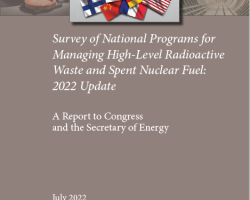Category of Content
Siting Experience Documents Only
Publication Date
Subject Matter
Status Report- Modeling of Pit Initiation
Status Report- Modeling of Pit Initiation
Thermal and Deposition Modeling of the Canister Deposition Field Demonstration
Thermal and Deposition Modeling of the Canister Deposition Field Demonstration
FY21 Small Scale Drying FY21 Interim Report
FY21 Small Scale Drying FY21 Interim Report
Development of Mockups and Instrumentation for Spent Fuel Drying Tests
Development of Mockups and Instrumentation for Spent Fuel Drying Tests
Modeling and Analysis to Support Spent Nuclear Fuel Drop Tests
Modeling and Analysis to Support Spent Nuclear Fuel Drop Tests
Small-Scale Drying FY2020 Interim Report
Small-Scale Drying FY2020 Interim Report
Modeling and Analysis for Spent Nuclear Fuel Seismic Testing
Modeling and Analysis for Spent Nuclear Fuel Seismic Testing
Small-Scale Drying: FY2019 Interim Report
Small-Scale Drying: FY2019 Interim Report
Small-Scale Drying FY2020 Interim Report
Small-Scale Drying FY2020 Interim Report
Update on the Simulation of Commercial Drying of Spent Nuclear Fuel
Update on the Simulation of Commercial Drying of Spent Nuclear Fuel
Interim Storage, Environmental Justice, and Generational Equity
Interim Storage, Environmental Justice, and Generational Equity
With the termination of the Yucca Mountain project, which was proposed to be our nation’s first repository for the disposal of military and civilian spent nuclear fuel and high-level radioactive waste, the future of nuclear waste management and disposal in this country became increasingly uncertain. Interim storage has been advocated by many as a temporary solution while a permanent solution is studied for potentially several more decades to come.
Survey of National Programs for Managing High-Level Radioactive Waste and Spent Nuclear Fuel: 2022 Update
Survey of National Programs for Managing High-Level Radioactive Waste and Spent Nuclear Fuel: 2022 Update
In October 2009, the U.S. Nuclear Waste Technical Review Board (Board or NWTRB) published Survey of National Programs for Managing High-Level Radioactive Waste and Spent Nuclear Fuel. For each of the 13 national programs studied, the report catalogued 15 institutional arrangements that had been set in place and 15 technical approaches that had been taken to design repository systems for the long-term management of high-activity radioactive waste.

